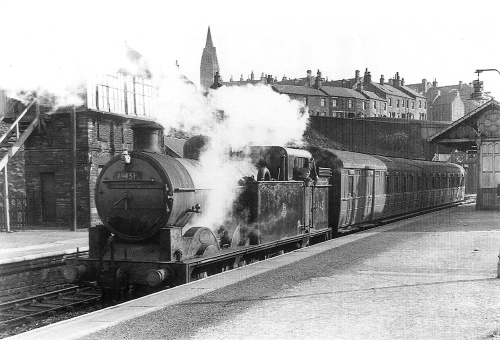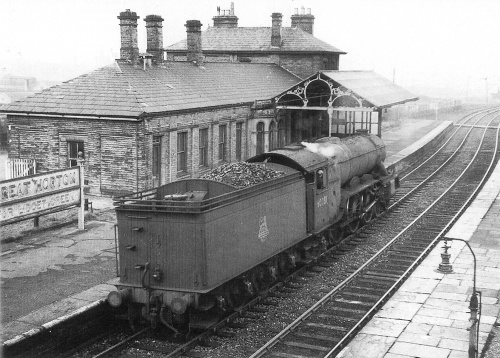Great Hotton was my attempt at modelling the former Great Northern Railway station at Great Horton in 4mm (00). The project has now been permanently shelved following moisture damage to the layout. A new replacement layout is being planned based on another part of the Queensbury Lines railway system.
What is Great Hotton?
 Since returning to the hobby a few years ago I’d made several attempts at building layouts. All of them were completely fictional and all shared the same inherent problems; too ambitious for the time, space and budget I had available. So in early 2012, when the usual sense of despondency and disillusionment had set in, I decided upon a radical change of direction to something smaller and more manageable that hopefully I could get some real progress with.
Since returning to the hobby a few years ago I’d made several attempts at building layouts. All of them were completely fictional and all shared the same inherent problems; too ambitious for the time, space and budget I had available. So in early 2012, when the usual sense of despondency and disillusionment had set in, I decided upon a radical change of direction to something smaller and more manageable that hopefully I could get some real progress with.
The new layout would be built to several criteria:
It would be a fiddle yard – fiddle yard arrangement rather than a roundy-roundy and would take up one side only of my available 16′ x 8′ shed space.
It would be built as semi-portable with a lightweight all-ply construction, enabling me to build outside or in the house.
I would be attempting to build my own trackwork to 00-SF standards so the track plan should be fairly simple without too many turnouts.
Like my earlier failed attempts it would be an ex-GNR line set somewhere in the West Riding of Yorkshire in the 1950s. However this time the emphasis would be placed on local services and goods rather than expresses passing through.
Finally I wanted to set myself defined goals with reasonable time frames to keep the project moving.
Where?
The first goal would be to have everything researched and planned and start building baseboards by the end of March 2011 and I decided to look at the Bradford-Queensbury-Halifax/Keighley lines for inspiration as I live just up the road. Dubbed by drivers as the “Alpine Route” due to its steep gradients and curving nature, this suburban railway network was built at a huge cost to the GNR and involved some considerable engineering challenges including several long tunnels, cuttings and viaducts.
Ideally I needed a compact urban site with goods facilities set in an undulating landscape. Most of the stations on the Queensbury lines were semi-rural and quite sprawling in nature but one seemed to fit the bill nicely: Great Horton. An evening’s planning session resulted in a suitable track plan. Inevitably a number of sidings as well as the coal depot had to be omitted, the length compressed to around 75% of the actual size and several elements had to be moved or combined. However, I was able to retain many of the key features and maintain the overall feel of the place.
When?
The Queensbury lines closed to passengers in 1955 but remained open (at least in truncated form) to goods until 1965. Great Horton itself remained a fully staffed station until the end with much of the passenger infrastructure remaining in place for some time after 1955. This lends itself nicely to a multi-mode approach and I plan to operate in two eras:
Era 1) Queensbury Lines – 1948-1955
 Regular passenger services were almost exclusively in the hands of Ivatt N1s hauling short trains of Gresley or Thompson suburban stock. A daily King’s Cross through coach was worked from Halifax. Freight was handled by J6s, J39s or J50s with B1s appearing later in the period. Ex-LMS interlopers such as Black 5s, Crabs and the occasional Stanier 8F could also be seen from time to time working through from Halifax. Typical goods handled at Great Horton were coal, parcels and woolen bales. There was also a private siding for coke deliveries to an iron works. Through goods traffic to/from elsewhere on the line included timber, coal, livestock and livestock feed, confectionary from the Mackintosh factory in Halifax, fireclay, stone and concrete. The line was also used for excursion traffic and football and cricket specials for Bradford Park Avenue. This is also an fascinating period for liveries with early BR colour schemes only gradually replacing the Big Four liveries.
Regular passenger services were almost exclusively in the hands of Ivatt N1s hauling short trains of Gresley or Thompson suburban stock. A daily King’s Cross through coach was worked from Halifax. Freight was handled by J6s, J39s or J50s with B1s appearing later in the period. Ex-LMS interlopers such as Black 5s, Crabs and the occasional Stanier 8F could also be seen from time to time working through from Halifax. Typical goods handled at Great Horton were coal, parcels and woolen bales. There was also a private siding for coke deliveries to an iron works. Through goods traffic to/from elsewhere on the line included timber, coal, livestock and livestock feed, confectionary from the Mackintosh factory in Halifax, fireclay, stone and concrete. The line was also used for excursion traffic and football and cricket specials for Bradford Park Avenue. This is also an fascinating period for liveries with early BR colour schemes only gradually replacing the Big Four liveries.
Era 2) Queensbury Lines – 1955-1965
 Passenger services ended in 1955 and with them went the N1s. However, 1956 saw the line used for driver training of the new Derby Lightweight DMUs (much to the chagrin of line closure protesters). Excursion traffic continued for a while until the lines were severed. As the lines were gradually cut back towards closure, other motive power appeared more regularly such as WDs, 8Fs and diesel shunters. Through traffic to Denholme (where there was a timber yard) continued until 1961 and continued to Thornton until 1965. The line was also used for a number of ‘experiments’ in this period which would see the use of English Electric Type 1s, an A3 pacific and a G5.
Passenger services ended in 1955 and with them went the N1s. However, 1956 saw the line used for driver training of the new Derby Lightweight DMUs (much to the chagrin of line closure protesters). Excursion traffic continued for a while until the lines were severed. As the lines were gradually cut back towards closure, other motive power appeared more regularly such as WDs, 8Fs and diesel shunters. Through traffic to Denholme (where there was a timber yard) continued until 1961 and continued to Thornton until 1965. The line was also used for a number of ‘experiments’ in this period which would see the use of English Electric Type 1s, an A3 pacific and a G5.
Why Great Hotton and not Great Horton?
It’s not intended to be a slavish recreation of Great Horton and I feel that there are too many compromises to call it so. However, I hope that it will capture the essence of the place and the Queensbury lines in general so I wanted something close. Hotten is the large nearby town to Emmerdale in the fictional soap so that name was swiftly borrowed and modified.
Further updates will appear on this blog but you can see a blow-by-blow account of the first year’s progress on my old RMWeb blog here.
The layout is now two years into the build with the trackwork and wiring complete. However, the build is on hiatus due to some problems and whilst I work on Bowling Street Goods.
I remember Great Horton Station very well from my boyhood days, having lived within sight of the station on Cumberland Road (to the north) in the 1950s. Recently, I posted on Wikipedia a mix of memories and research about this station specifically which you may find to be of interest. Just enter ‘Great Horton railway station’ into Wikipedia’s search box. … Somewhere in one of a boxful of books I own, there is a plan of the Great Horton Station, which detailed the trackwork and layout. I really enjoyed seeing that first (top) excellent picture of the station, having crossed that metal pedestrian bridge many times, as well as (illegally!) trespassed on various tracks and sidings. And, yes, chased by bobbies more than once!
By: Rimas on February 21, 2015
at 6:04 pm
Thanks for the info. Always nice to have more human stories of places that help to bring them to life.
By: aj427 on February 24, 2015
at 12:36 pm
There are some excellent aerial views taken in 1947 of the Great Horton Station at:
http://www.britainfromabove.org.uk/asearch?search=beckside
which are actually for the Beckside Worsted Mills, but which also show the station and adjacent features from almost every angle. (Use search-term ‘Beckside’).
Might prove helpful to modellers!
By: Rimas on February 28, 2015
at 8:18 pm